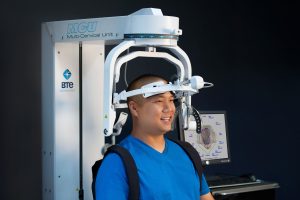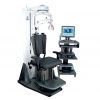
A New Take on WAD & Neck Pain – Webinar on Demand
Treatment GuidelinesTraditional methods can only provide so much relief for severe neck pain and injuries. Explore an evidence-based approach focusing on a detailed assessment on range of motion and strength, and strengthening the neck itself.
Neck pain is one of the most common health complaints today. If you work with patients suffering from whiplash-associated disorder (WAD), neck pain or back pain, you’ve likely used manual therapy to treat it. In a recent webinar produced by Physiquipe, I presented an exciting, innovative, and proven way to treat neck pain: focus on detailed assessment of range of motion and strength as well as strengthening. Rather than manipulation, cryotherapy, dry needling, or other traditional methods, we discussed muscular strength and symmetry as the underlying cause of neck pain.
Using BTE’s premiere cervical spine evaluation and treatment system, the Multi-Cervical Unit (MCU), you can assess and improve strength and ROM of the neck and help your clients get relief from chronic neck pain. Watch the webinar on demand below.
The following article from Physiquipe summarizes the major takeaways from the live webinar:
Neck pain: Is strength the missing link…
Neck pain is one of the biggest problems within healthcare. Manual therapy is the most common treatment for this but is the missing link strength? This is the opinion of several leading clinicians and researchers and so this webinar looked in to this evidence and discussed how the BTE Multi Cervical Unit can address this.
70% of people will experience neck pain in our lifetime. It is one of top five leading causes of disability and has a huge financial impact on healthcare systems. Women are more affected than men (1.38x more likely). Also, there is a direct correlation between the duration of neck pain and likelihood of pain resolution within 2 months. The longer the problem, the longer A problem!
There are several known causes of neck pain such as headaches and torticollis but we discussed that the big issue is muscle weakness and imbalance. The head is like a bowling ball on a stick (interesting image!!) so having strong muscles in the neck and shoulders is critical. If muscles do not work in unison it is a problem and symmetry is very important to avoid neck pain.
Aging, trauma, disease all play an impact in neck pain but the things we CAN effect are posture, job/work (can we create a more ergonomic environment?) and a new but huge and growing issue is texting! Looking down at your phone for 8 hours a day is inevitably going to cause problems in months and years to come…
Road Traffic Accidents are a significant cause of WADs with up to 60% of those hit from behind being symptomatic after 6 months and up to 40% are symptomatic after 2 years. This is a huge financial cost as well as the physical issues it causes the patient.
Current methods of evaluation for neck pain are manual muscle testing, which can work but has limited ability to detect discrete differences in strength and questionnaires. The next step is scans (such as Xrays MRIs or CTs) which are more expensive and can certainly give insight but how do they apply to function?
Treatment of neck pain is commonly addressed with medication, which can help mask some of the pain but its not addressing the real issue. Manual therapy, cryo/heat therapy, dry needling and tools like laser, IASTM can be really helpful. Shockwave for trigger pointing can help with spasm but still aren’t addressing the underlying problem. To do this, strengthening is absolutely key. This is a heavily researched area so please see further information here. Weak muscles lead to joint instability. If a person is too weak you can do some isometric exercise. When they can tolerate it when need to do isotonic exercise. It needs to be functional!
So how do we strengthen? We can do manual therapy in the form of isometric exercise against the hand, which can be very effect to a certain point. Theraband is also an inexpensive way to exercise but is quite difficult to set up to do correct movements. There are quite a few ‘interesting’ harness systems out there but still not much objectivity!
A significant point in these methods is: How do you document progress?
This is where the Multi Cervical Unit is unique and has been said to be ‘the missing link in Neck pain’.
It is used to isolate the function of the cervical spine giving the clinician the ability to objectively determine safe AND effective resistance levels for each movement. It has a great success (over 90% of patients experience positive outcomes and improved quality of life) across various populations. It comprises a Range Of Motion (ROM) and strength assessment giving direct comparisons between right and left AND normative data (American Medical Association data). It also gives a consistency of effort score which is a helpful tool in identifying if the patient is giving a true effort on not…
Research suggest that the coefficient of variation needs to be below 15% to demonstrate a true effort. All of this data is compiled in to a simple report including a radar graph which gives a clear and easy to understand indication of deficiencies, if this is the case.
The MCU also provides the ability to address any deficiencies that are found in the assessment. It has a versatile weight stack with 22 default exercises at neutral and specific angles, and the ability to create new exercises at more unique angles. The new software gives a graphic display of the quality of each repetition. ‘Work’ data to show how much exercise was performed rather than just repetitions. This gives a more accurate reflection of performance. Progress reports demonstrate how much a patient is improving, or not! There is a significant difference of the MCU vs Theraband in several studies.
In conclusion:
- Do not be afraid to treat the cervical spine. Movement is medicine!
- Technology can be your guide throughout the rehabilitation process
- Be innovative and unique in the offerings you provide your patients
- Objective documentation is key to showing efficacy of rehab program
As rehab professionals, we know that muscular strength is a vital factor that contributes to muscle and joint pain, but this concept is not commonly applied to the neck and back. By addressing strength, you can help your WAD and neck/back pain patients get back to their lives with less pain.
With the MCU, you can provide objective neck measurements and progressive treatment for your clients. The latest MCU software upgrade expands your capabilities to customize protocols, present streamlined reports, and integrate with your EMR. So you get a smoother, easier and quicker workflow, and your patients get a superior rehab experience.
For more virtual learning, watch this webinar all about eccentrics in rehab. Subscribe to TherapySpark for the latest rehab techniques, resources, and updates.
Jeff Johnson, MA, ATC
Clinical Specialist
BTE




